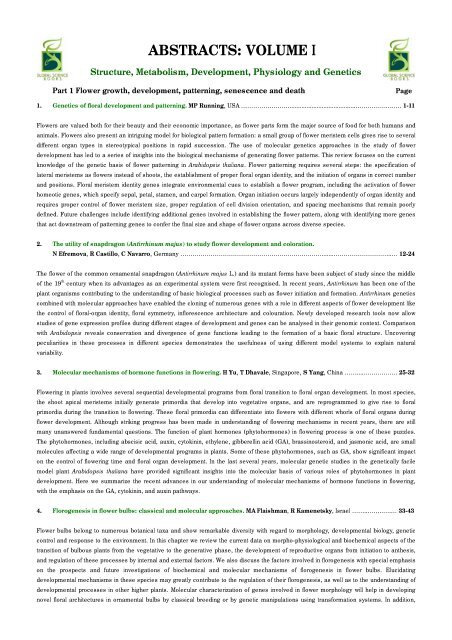Floriculture, Ornamental and Plant Biotechnology - Global Science ...
Floriculture, Ornamental and Plant Biotechnology - Global Science ...
Floriculture, Ornamental and Plant Biotechnology - Global Science ...
Create successful ePaper yourself
Turn your PDF publications into a flip-book with our unique Google optimized e-Paper software.
ABSTRACTS: VOLUME I<br />
Structure, Metabolism, Development, Physiology <strong>and</strong> Genetics<br />
Part 1 Flower growth, development, patterning, senescence <strong>and</strong> death Page<br />
1. Genetics of floral development <strong>and</strong> patterning. MP Running, USA …………………….......................................……………..…… 1-11<br />
Flowers are valued both for their beauty <strong>and</strong> their economic importance, as flower parts form the major source of food for both humans <strong>and</strong><br />
animals. Flowers also present an intriguing model for biological pattern formation: a small group of flower meristem cells gives rise to several<br />
different organ types in stereotypical positions in rapid succession. The use of molecular genetics approaches in the study of flower<br />
development has led to a series of insights into the biological mechanisms of generating flower patterns. This review focuses on the current<br />
knowledge of the genetic basis of flower patterning in Arabidopsis thaliana. Flower patterning requires several steps: the specification of<br />
lateral meristems as flowers instead of shoots, the establishment of proper floral organ identity, <strong>and</strong> the initiation of organs in correct number<br />
<strong>and</strong> positions. Floral meristem identity genes integrate environmental cues to establish a flower program, including the activation of flower<br />
homeotic genes, which specify sepal, petal, stamen, <strong>and</strong> carpel formation. Organ initiation occurs largely independently of organ identity <strong>and</strong><br />
requires proper control of flower meristem size, proper regulation of cell division orientation, <strong>and</strong> spacing mechanisms that remain poorly<br />
defined. Future challenges include identifying additional genes involved in establishing the flower pattern, along with identifying more genes<br />
that act downstream of patterning genes to confer the final size <strong>and</strong> shape of flower organs across diverse species.<br />
2. The utility of snapdragon (Antirrhinum majus) to study flower development <strong>and</strong> coloration.<br />
N Efremova, R Castillo, C Navarro, Germany …………………………………………….……………….......………………………..… 12-24<br />
The flower of the common ornamental snapdragon (Antirrhinum majus L.) <strong>and</strong> its mutant forms have been subject of study since the middle<br />
of the 19 th century when its advantages as an experimental system were first recognised. In recent years, Antirrhinum has been one of the<br />
plant organisms contributing to the underst<strong>and</strong>ing of basic biological processes such as flower initiation <strong>and</strong> formation. Antirrhinum genetics<br />
combined with molecular approaches have enabled the cloning of numerous genes with a role in different aspects of flower development like<br />
the control of floral-organ identity, floral symmetry, inflorescence architecture <strong>and</strong> colouration. Newly developed research tools now allow<br />
studies of gene expression profiles during different stages of development <strong>and</strong> genes can be analysed in their genomic context. Comparison<br />
with Arabidopsis reveals conservation <strong>and</strong> divergence of gene functions leading to the formation of a basic floral structure. Uncovering<br />
peculiarities in these processes in different species demonstrates the usefulness of using different model systems to explain natural<br />
variability.<br />
3. Molecular mechanisms of hormone functions in flowering. H Yu, T Dhavale, Singapore, S Yang, China …….....……………. 25-32<br />
Flowering in plants involves several sequential developmental programs from floral transition to floral organ development. In most species,<br />
the shoot apical meristems initially generate primordia that develop into vegetative organs, <strong>and</strong> are reprogrammed to give rise to floral<br />
primordia during the transition to flowering. These floral primordia can differentiate into flowers with different whorls of floral organs during<br />
flower development. Although striking progress has been made in underst<strong>and</strong>ing of flowering mechanisms in recent years, there are still<br />
many unanswered fundamental questions. The function of plant hormones (phytohormones) in flowering process is one of these puzzles.<br />
The phytohormones, including abscisic acid, auxin, cytokinin, ethylene, gibberellin acid (GA), brassinosteroid, <strong>and</strong> jasmonic acid, are small<br />
molecules affecting a wide range of developmental programs in plants. Some of these phytohormones, such as GA, show significant impact<br />
on the control of flowering time <strong>and</strong> floral organ development. In the last several years, molecular genetic studies in the genetically facile<br />
model plant Arabidopsis thaliana have provided significant insights into the molecular basis of various roles of phytohormones in plant<br />
development. Here we summarize the recent advances in our underst<strong>and</strong>ing of molecular mechanisms of hormone functions in flowering,<br />
with the emphasis on the GA, cytokinin, <strong>and</strong> auxin pathways.<br />
4. Florogenesis in flower bulbs: classical <strong>and</strong> molecular approaches. MA Flaishman, R Kamenetsky, Israel ……..….….….… 33-43<br />
Flower bulbs belong to numerous botanical taxa <strong>and</strong> show remarkable diversity with regard to morphology, developmental biology, genetic<br />
control <strong>and</strong> response to the environment. In this chapter we review the current data on morpho-physiological <strong>and</strong> biochemical aspects of the<br />
transition of bulbous plants from the vegetative to the generative phase, the development of reproductive organs from initiation to anthesis,<br />
<strong>and</strong> regulation of these processes by internal <strong>and</strong> external factors. We also discuss the factors involved in florogenesis with special emphasis<br />
on the prospects <strong>and</strong> future investigations of biochemical <strong>and</strong> molecular mechanisms of florogenesis in flower bulbs. Elucidating<br />
developmental mechanisms in these species may greatly contribute to the regulation of their florogenesis, as well as to the underst<strong>and</strong>ing of<br />
developmental processes in other higher plants. Molecular characterization of genes involved in flower morphology will help in developing<br />
novel floral architectures in ornamental bulbs by classical breeding or by genetic manipulations using transformation systems. In addition,

















